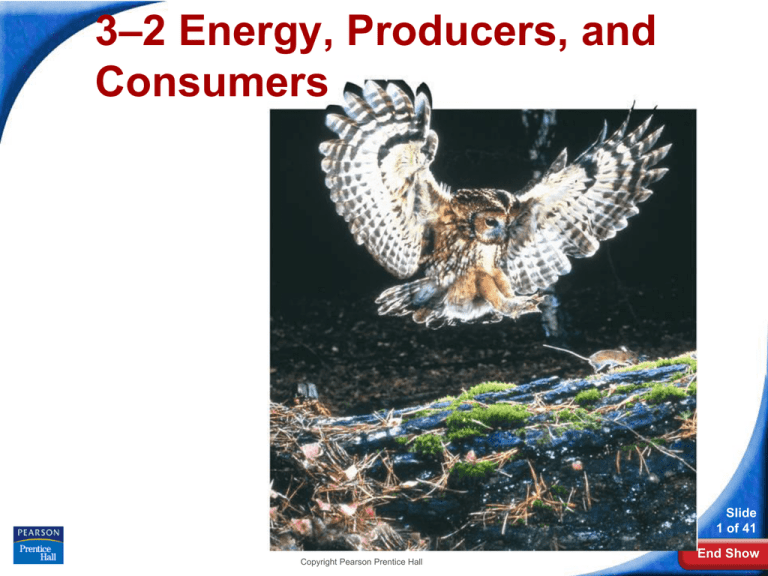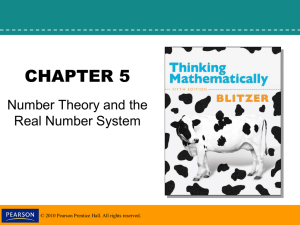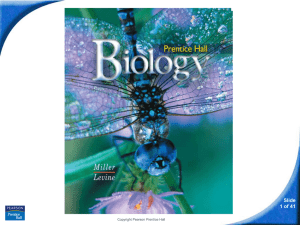
3–2 Energy, Producers, and
Consumers
Slide
1 of 41
Copyright Pearson Prentice Hall
End Show
3–2 Energy Flow
Producers
Producers
Without a constant input of energy,
living systems cannot function.
Sunlight is the main energy source
for life on Earth.
Slide
2 of 41
Copyright Pearson Prentice Hall
End Show
3–2 Energy Flow
Producers
In a few ecosystems, some organisms obtain
energy from a source other than sunlight.
Some types of organisms rely on the
energy stored in inorganic chemical
compounds.
Slide
3 of 41
Copyright Pearson Prentice Hall
End Show
3–2 Energy Flow
Producers
Only plants, some algae, and certain bacteria
can capture energy from sunlight or chemicals
and convert it into forms that living cells can use.
These organisms are called autotrophs.
Autotrophs use energy from the environment to
produce “food” by assembling simple inorganic
compounds into complex organic molecules.
Autotrophs not only feed themselves but store
energy and provide it to other organisms that eat
them.
Slide
4 of 41
Copyright Pearson Prentice Hall
End Show
3–2 Energy Flow
Producers
They are called primary producers because
they are the first producers of energy-rich
compounds that are later used by other
organisms.
Slide
5 of 41
Copyright Pearson Prentice Hall
End Show
3–2 Energy Flow
Producers
Energy From the Sun
The best-known autotrophs harness solar energy
through a process known as photosynthesis.
During photosynthesis, these autotrophs use light
energy to convert carbon dioxide and water into
oxygen and energy-rich carbohydrates.
Slide
6 of 41
Copyright Pearson Prentice Hall
End Show
3–2 Energy Flow
Producers
Photosynthesis is
responsible for
adding oxygen to—
and removing carbon
dioxide from—Earth's
atmosphere.
Slide
7 of 41
Copyright Pearson Prentice Hall
End Show
3–2 Energy Flow
Producers
Plants are the main autotrophs on land.
Algae are the main autotrophs in freshwater
ecosystems and in the upper layers of the ocean
Photosynthetic bacteria are important in certain wet
ecosystems such as tidal flats and salt marshes.
Slide
8 of 41
Copyright Pearson Prentice Hall
End Show
3–2 Energy Flow
Producers
Life Without Light
Some autotrophs can produce food in the absence
of light.
When organisms use chemical energy to produce
carbohydrates, the process is called
chemosynthesis.
Slide
9 of 41
Copyright Pearson Prentice Hall
End Show
3–2 Energy Flow
Producers
Slide
10 of 41
Copyright Pearson Prentice Hall
End Show
3–2 Energy Flow
Producers
Chemosynthesis is performed by several
types of bacteria.
These bacteria represent a large proportion
of living autotrophs.
Some chemosynthetic bacteria live in very
remote places on Earth, such as volcanic
vents on the deep-ocean floor and hot
springs.
Others live in more common places, such as
tidal marshes along the coast.
Slide
11 of 41
Copyright Pearson Prentice Hall
End Show
3–2 Energy Flow
Consumers
Consumers
Many organisms cannot harness energy directly
from the physical environment.
Organisms that rely on other organisms for their
energy and nutrients are called heterotrophs.
Heterotrophs are also called consumers.
Slide
12 of 41
Copyright Pearson Prentice Hall
End Show
3–2 Energy Flow
Consumers
Types of Consumers
Consumers are classified by the ways in which
they acquire energy and nutrients.
• Herbivores eat plants.
• Carnivores kill and eat other animals.
• Omnivores eat both plants and animals.
• Detritivores feed on plant and animal remains
(detritus) and other dead matter.
Slide
13 of 41
Copyright Pearson Prentice Hall
End Show
3–2 Energy Flow
Types of Consumers (cont.)
• Scavengers are animals that consume the
carcasses of other animals that have been killed by
predators or have died of other causes.
• Decomposers, like bacteria and fungi, break down
organic matter.
Slide
14 of 41
Copyright Pearson Prentice Hall
End Show
3–2 Energy Flow
Beyond Consumer Categories
Categorizing consumers is important, but these
simple categories often don’t express the real
complexity of nature.
For example, herbivores that eat different plant
parts often differ greatly in the ways they obtain
and digest their food.
In addition, organisms in nature often do not stay
inside the categories we put them in.
For example, some carnivores will scavenge if
they get the chance. Many aquatic animals eat a
mixture of algae, bits of animal carcasses, and
detritus particles.
Slide
15 of 41
End Show








